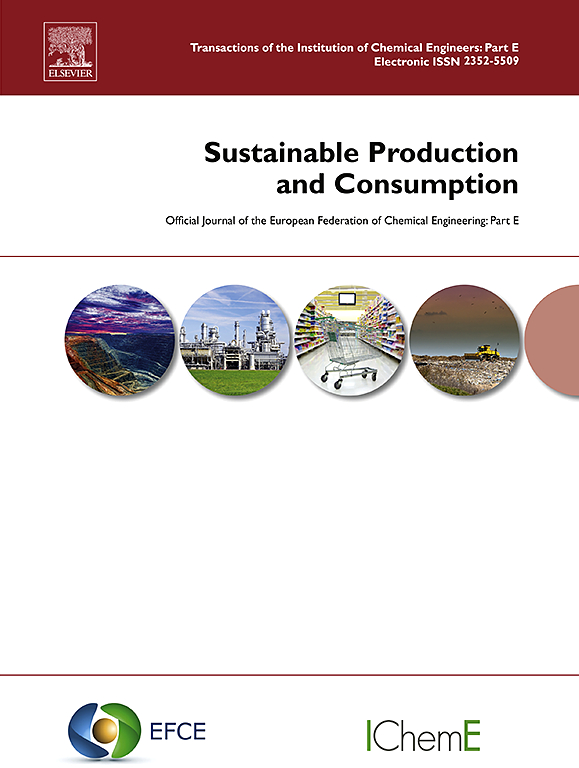使用新设计方法采用可持续设计做法的障碍和推动因素 - 加快制造业的可持续转型
IF 10.9
1区 环境科学与生态学
Q1 ENVIRONMENTAL STUDIES
引用次数: 0
摘要
产品开发和制造组织在可持续发展转型方面举步维艰,没有为可持续生产和消费做出足够的贡献。与此同时,设计研究人员开发并提出了大量新的、经过改进的设计方法,以支持制造业进行这种转型。尽管如此,有文献充分证明,工业界采用这些建议的设计方法具有挑战性。以往在设计领域的研究主要是从流程和方法的角度来研究这个问题,而以往在管理领域的研究则侧重于组织和人类行为方面。这就造成了一个研究空白,需要更多的跨学科研究,从所有三个角度(即过程和方法、组织和人类行为)来研究设计方法的采用。我们对三个不同的产品开发和制造组织进行了六项平行案例研究,以收集定性经验数据。格拉塞基础理论被用来分析收集到的数据。最终形成了一个描述性框架,其中包含 53 个影响采用新的和改进的设计方法进行可持续设计实践的跨学科因素。该描述性框架与跨学科文献进行了比较,以进一步澄清和解释研究结果,突出了实践和理论意义。本研究为理论和实践做出了三大贡献:(1) 引入并使用了两个新概念来解释实证研究结果,这两个概念被称为设计方法的二元论和情境设计问题;(2) 提出了九个系统性障碍和八个命题,这些障碍和命题强调了工业设计实践范式转变的必要性、组织内部的认知偏差如何导致伪可持续性状态,以及提高组织信息和数据管理能力的必要性;(3) 可持续设计思维旨在提供可持续设计的基本能力,系统地挑战组织内部的认知偏差,因此被认为是解决几个主要障碍的潜在推动因素。本文章由计算机程序翻译,如有差异,请以英文原文为准。
Barriers and enablers for the adoption of sustainable design practices using new design methods – Accelerating the sustainability transformation in the manufacturing industry
Product development and manufacturing organizations struggle in their sustainability transformation and do not sufficiently contribute to sustainable production and consumption. Design researchers, at the same time, develop and propose a plethora of new and improved design methods that can support the manufacturing industry in such transformation. It is, despite this, well-documented in literature that the industrial adoption of such proposed design methods is challenging. Previous research in the design domain has mainly studied this issue from a process and methodological perspective, whereas previous research in the management domain instead has focused on organizational, and human-behavioral aspects. This poses a research gap for more interdisciplinary research that studies the adoption of design methods from all three perspectives (i.e., process and methodology, organization, and human behavior). Six parallel case studies were carried out with three different product development and manufacturing organizations to collect qualitative empirical data. Glaserian grounded theory was used to analyze the collected data. This resulted in a descriptive framework that captures 53 interdisciplinary factors influencing the adoption of sustainable design practices using new and improved design methods. The descriptive framework is compared to interdisciplinary literature to further clarify and explain the findings, highlighting both practical and theoretical implications. This research provides three main contributions to theory and practice: (1) Two new concepts are introduced and used to explain the empirical findings, which are referred to as the dualism of design methods, and the situational design problem; (2) Nine systemic barriers and eight propositions are formulated, which highlight the need for a paradigm shift in how design is practiced in industry, how cognitive biases inside organizations can lead to a state of pseudo-sustainability, and the need for improved information and data management capabilities in organizations; (3) Sustainable design thinking is proposed as an potential enabler to address several of the main barriers, as it aims to provide a base competence of sustainable design to systematically challenge cognitive biases inside organizations.
求助全文
通过发布文献求助,成功后即可免费获取论文全文。
去求助
来源期刊

Sustainable Production and Consumption
Environmental Science-Environmental Engineering
CiteScore
17.40
自引率
7.40%
发文量
389
审稿时长
13 days
期刊介绍:
Sustainable production and consumption refers to the production and utilization of goods and services in a way that benefits society, is economically viable, and has minimal environmental impact throughout its entire lifespan. Our journal is dedicated to publishing top-notch interdisciplinary research and practical studies in this emerging field. We take a distinctive approach by examining the interplay between technology, consumption patterns, and policy to identify sustainable solutions for both production and consumption systems.
 求助内容:
求助内容: 应助结果提醒方式:
应助结果提醒方式:


